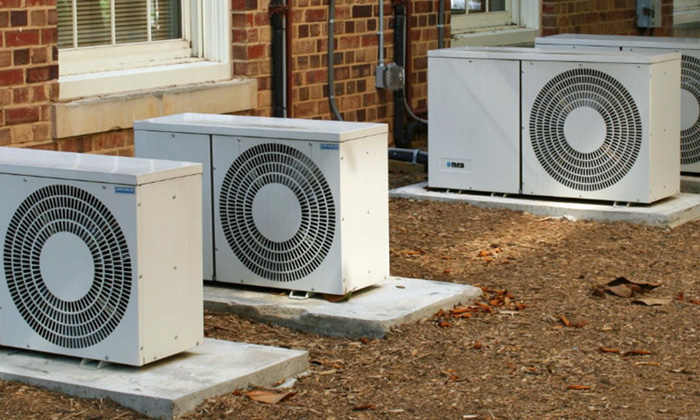An air conditioner takes heat out of a house (cooling it) and transfers the heat into the air around the house. Through the use of a reversing valve, a suitably equipped air conditioner takes heat out of the air around the house and transfers it to the house interior (heating it). In this mode, the air conditioner functions as an air source heat pump.
Such heat pumps transfer heat into a house even when outside temperatures are low. Someone may wonder how it is possible to take heat out of cold air. We don’t have to look far for an example of an appliance that performs exactly that function for us regularly: a refrigerator. Our refrigerator’s freezer compartment shows a temperature of -20°C. The temperature in our house is +23°C. The refrigerator takes heat out of a cold space (the freezer) and transfers the heat to the warm air surrounding the refrigerator.
An air source heat pump is significantly more effective in delivering heat to a house than an electric furnace. An electric furnace is considered to be 100% efficient. That means that for every unit of energy consumed by the furnace, it provides 1 unit of heat energy to the house. An air source heat pump provides much more heat into the house, by a factor called the coefficient of production (COP). For a COP of 3, an air source heat pump provides 3 units of heat energy for every unit of energy consumed. The explanation for this is that an electric furnace must produce heat by forcing an electric current through a heating element, whereas an air source heat pump simply transfers heat that already exists.
The COP falls off as outside temperatures fall, but not as much as one would expect. The COP for our system for an outside temperature of 15°C is given as 4.7. The COP at -9°C is given as 2.5, still a remarkable value. We have our system set to operate down to -9°C; when it is colder, the furnace heats the house.
The information I gathered indicated that using an air source heat pump in combination with an advanced HRV (heat recovery ventilation system) would have a return on investment of almost 12% annually, most of which comes from the air source heat pump. This may sound high considering that Manitoba temperatures go much lower than -9°C in winter, below which our heat pump is not functioning. However, the operating period for an air source heat pump would include outdoor temperatures ranging from –9°C in our case to whenever our thermostat calls for heat, say +15°C, possibly higher. That represents many days and nights, in at least 8 months of the year. In that extended period, combined with a higher COP at higher outdoor temperatures as noted earlier, the heat pump can provide significant savings.
The provision and installation of an air source heat pump at our house has not gone well. When we specified the necessary equipment as suggested by Gio Robson, our general contractor provided us with the price, and proceeded to build the house. His HVAC retailer/contractor was able to order the specified equipment. However, the general contractor’s usual electrician was not familiar with this equipment and refused to install it. Although the HVAC contractor’s technicians were familiar with installing and setting up air conditioners, they were not sufficiently trained or experienced to set up the air source heat pump with anything close to expected performance. Our air conditioner works fine in the cooling mode, but as an air source heat pump it is basically non-functional at present.
We have called upon outside expertise for troubleshooting our system. This looked promising, but when the bill reached $2500 and climbing, we decided not to continue the effort.
I still hope to get a properly functioning air source heat pump from my contractor. The HVAC technicians have made numerous trips to try to get our system operational, without full success. Further work has been delayed by the COVID epidemic. I am not optimistic that the same people will be successful without further training or assistance. I also don’t know what recourse I have if they are not successful.
I am convinced that the air source heat pump, widely used in North America in residential and commercial sectors for decades, is an established technology and holds a lot of potential. There are fully functioning installations in Manitoba.
I need to rate our air source heat pump experience as a “not yet” success at best.




